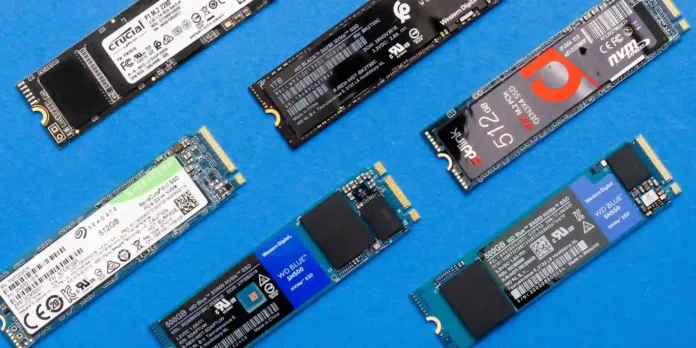The majority of computers and storage drives presently utilize the commonly used SATA or PCIe 3.0 interfaces to transfer your data bits. However, if you are fortunate enough to possess a relatively up-to-date PC, there is a possibility of upgrading to a solid-state drive (SSD) constructed on the incredibly rapid PCIe 4.0 protocol. After conducting numerous tests on various PCIe 4.0 SSDs, we have determined that the Solidgm P44 Pro is the most exceptional option among tough competitors due to its astonishingly high speeds, comparable only to the next-generation PCIe 5.0 SSDs. Continue reading to acquire more information, including what to consider when selecting a PCIe 4.0 SSD. Updated on 12/28/2023: We have now included the Solidigm P41 as our recommendation for the best budget-friendly PCIe 4.0 drive runner-up. In our summary below, you can find out why this affordable newcomer has left a lasting impression on us.
Solidigm P44 Pro SSD – Best PCIe 4.0 SSD
| Pros | Cons |
|---|---|
| Fastest PCIe 4.0 SSD to date DRAM facilitates excellent random performance Synergy low-level Windows driver improves random performance further | Inconsistent pricing on web |
WD Black SN850X – Best PCIe 4.0 SSD runner-up
| Pros | Cons |
|---|---|
| Excellent performance Decently affordable given its speed Available up to 4TB Optional heatsink for 1/2TB models | Pricey per gigabyte Somewhat parsimonious TBW ratings |
WD Blue SN580 SSD – Best budget PCIe 4.0 SSD
| Pros | Cons |
|---|---|
| Fantastically affordable Super fast real world transfers Single-sided for laptop upgrades | Slows to less than 300MBps when writing off secondary cache Slightly low endurance rating |
Solidigm P41 Plus SSD – Best budget PCIe 4.0 SSD
| Pros | Cons |
|---|---|
| Super affordable Good everyday performance | Slowed significantly on our long 450GB write |
WD Black SN770M – Best for Steam Deck
| Pros | Cons |
|---|---|
| Small 2230 form factor for handheld gaming rigs Up to 2TB of capacity Very good real-world performance 5-year warranty and good TBW ratings | Slow writes when secondary cache is exhausted Requires host memory buffer support (HMB) |
Seagate Game Drive – Best PCIe 4.0 SSD for PS5
| Pros | Cons |
|---|---|
| Very good overall performance Excellent 4K performance Low-profile heatsink Twice the TBW rating of the competition | A bit pricey No 4TB model |
What to look for in an SSD
When considering an SSD, there are several factors to take into account. However, the most important aspects to focus on are capacity, price, and warranty length. While three-year warranties are standard, there are higher-end models that offer guarantees for up to five years. Unlike older SSDs, modern drives are designed to withstand normal consumer usage without wearing out quickly. This has been proven through extensive endurance tests conducted by Tech Report.
Another crucial factor to consider is the technology used to connect the SSD to your PC. For more detailed information and guidance on which type of SSD to purchase, you can refer to our comprehensive guide. There are two main types of connections to be aware of:
SATA: This refers to the connection type and transfer protocol used for most 2.5-inch and 3.5-inch hard drives and SSDs. SATA III speeds can reach approximately 600MBps, with most modern drives achieving this maximum speed. However, there are exceptions, which will be discussed in the next section.
PCIe: This interface utilizes four of your computer’s PCIe lanes to achieve significantly faster speeds compared to SATA. It can deliver speeds of up to nearly 4GBps over PCIe gen3. PCIe is commonly paired with supercharged NVMe drives. Both the PCIe lanes on your motherboard and the M.2 slot can be used to support the PCIe interface. Additionally, adapters are available that allow you to install “gumstick” M.2 drives into a PCIe lane. It’s important to note that PCIe 4.0 drives offer even higher speeds, but they require an AMD Ryzen 3000-series or Intel Core 11th-gen (or newer) processor, along with a compatible PCIe 4.0 motherboard.
NVMe: Non-Volatile Memory Express technology utilizes the abundant bandwidth of PCIe to create exceptionally fast SSDs that outperform SATA-based drives. For a more detailed understanding of NVMe, you can refer to PCWorld’s comprehensive guide titled “Everything you need to know about NVMe”.
M.2: This form factor can be confusing, as many assume that all M.2 drives use NVMe technology and PCIe speeds. However, M.2 is simply a physical form factor. While most M.2 SSDs do utilize NVMe, there are still some that operate on SATA. It is important to conduct thorough research to ensure you select the right type for your needs. M.2 drives are commonly used in modern Ultrabooks for storage.
U.2 and mSATA: These are additional SSD formats that you may encounter, although motherboard support and product availability for these formats are relatively rare. Some older Ultrabooks may include mSATA drives, and they are still available for purchase if necessary.
While speed is undoubtedly important, it is worth noting that most modern SSDs saturate the SATA III interface. However, there are exceptions to this, and not all drives can achieve the maximum speed.
How we test SSDs
When testing SSDs, we utilize a combination of synthetic benchmarks, such as CrystalDiskMark 6’s various tests, and real-world tests. These tests include 48GB transfers to assess performance during common tasks, as well as a demanding 450GB transfer test that pushes an SSD’s cache performance to its limits. PCIe 4.0 testing is conducted using an MSI MEG X570 motherboard with an AMD Ryzen 7 3700X 8-core CPU, along with the same Kingston DRAM, cards, and software. All testing is performed on an empty or nearly empty drive. Please note that performance may decrease as the drive fills up.


